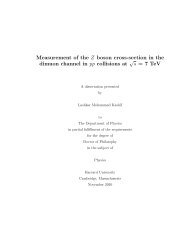2 The CDF Experiment at Fermilab Contents - Harvard University ...
2 The CDF Experiment at Fermilab Contents - Harvard University ...
2 The CDF Experiment at Fermilab Contents - Harvard University ...
Create successful ePaper yourself
Turn your PDF publications into a flip-book with our unique Google optimized e-Paper software.
86 Section 2: <strong>CDF</strong> Physics Analysis<br />
2.4.6 Di-Jet Mass Resolution<br />
(Prof. Schmitt & Dr. Dorigo)<br />
Our ability to extract a higgs signal over a large QCD background depends critically on<br />
the resolution we can <strong>at</strong>tain on the mass as calcul<strong>at</strong>ed directly from the two b-jets. If the<br />
resolution is poor, then it will be dicult to observe a peak from the higgs in the dijet mass<br />
spectrum. <strong>The</strong> better the resolution, the smaller the mass window we can dene for a signal,<br />
and the smaller the number of background events for a given luminosity.<br />
<strong>The</strong> expected resolution for a jet-jet resonance in Run I was roughly Mjj =0:1 M jj . A<br />
rel<strong>at</strong>ive improvement of this number by 30% would signicantly extend our discovery reach<br />
for the Higgs boson in Run II (see for example Ref. [17]). In order to achieve th<strong>at</strong> improvement<br />
we must study in detail the characteristics of b-quark jets emitted in the Higgs<br />
decay, and exploit fully the inform<strong>at</strong>ion provided by the all relevant detector components.<br />
For example, three-dimensional tracking in the new SVX II detector will allow us to infer<br />
the momentum of the escaping neutrinos in semileptonic b-quark decays, gre<strong>at</strong>ly improving<br />
the energy measurement of the resulting jets. This plan will work well in Run II, given the<br />
larger acceptance for charged leptons from semileptonic decays provided by the new plug<br />
calorimeter and the completion of the central muon system. Furthermore, the possibility<br />
of measuring track momenta up to a rapidity jj = 2:0, thanks to the new COT and silicon<br />
detectors, will allow a fruitful use of tracking inform<strong>at</strong>ion to improve the calorimetric<br />
measurement of jets.<br />
While searching for evidence of Z ! bb decays Dorigo succeeded in improving the dijet<br />
mass resolution for b-jets. He found th<strong>at</strong> the most useful quantities were the muon<br />
momentum, the projection of missing transverse energy along the jet axes, and the charged<br />
fraction of the jets. <strong>The</strong> muon momentum is needed in the correction of the jet origin<strong>at</strong>ed<br />
from the semileptonic decay of the parent b-quark, because the minimum ionizing muons do<br />
not contribute linearly to the energy measured in the calorimeter. <strong>The</strong> missing E T , projected<br />
along the jet directions in the transverse plane, provides useful inform<strong>at</strong>ion on the neutrino<br />
momentum and on possible uctu<strong>at</strong>ions of the energy measurement. <strong>The</strong> charged fraction of<br />
the jets, dened as the r<strong>at</strong>io between the total momentum of charged tracks belonging to a<br />
jet and the energy measured in the calorimeter, also helps to reduce the error in the energy<br />
measurement. By properly accounting for the value of these observables, it was possible to<br />
reduce the resolution of the dijet mass, M =M jj , by nearly 50% (see Fig. 42).















